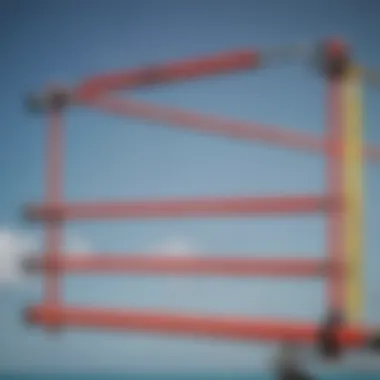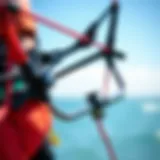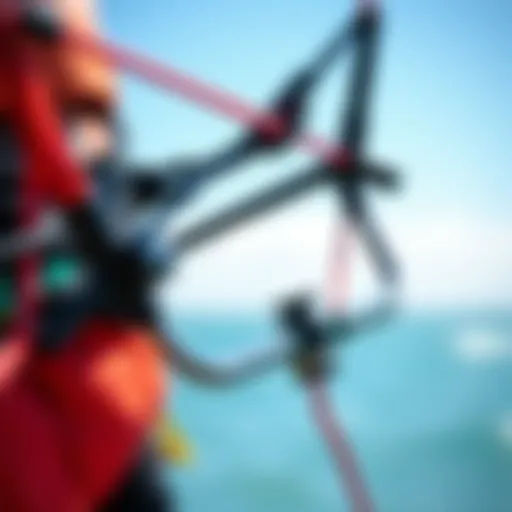A Guide to Choosing Spreader Bars for Kiteboarding


Intro
Kiteboarding is not just about catching waves; it’s about the intricate dance with the wind, and at the heart of this exhilarating sport lies the often-overlooked spreader bar. While many enthusiasts might focus solely on their kites and boards, understanding the significance of spreader bars can greatly enhance the entire kiteboarding experience. This guide aims to shed light on the types, features, and benefits of spreader bars, while addressing the misconceptions that may cloud the judgment of both newcomers and seasoned kiteboarders alike.
Gear Selection
Choosing the right gear is like setting the stage for a performance—everything matters. When selecting a spreader bar, it’s crucial to consider not just your skill level, but also the type of kite and board you intend to use.
Types of Kites
Kiteboarding encompasses a range of kite styles, each with its own set of characteristics. Here’s a quick rundown:
- Hybrid Kites: These versatile kites adapt well to various conditions and are beginner-friendly.
- Bow Kites: Recognized for their large surface area, they offer greater stability and control, making them ideal for mixed conditions.
- C-Kites: Known for their agility and power, these are preferred by experienced kiteboarders who crave speed and performance.
Your selection of spreader bar should align with your chosen kite type since compatibility plays a vital role in harnessing performance.
Choosing the Right Board
The board, much like the frame of a painting, complements the overall kiteboarding experience. Let’s consider a few types of boards:
- Directional Boards: Designed for surfing-style riding, these are perfect for those who love carving through waves.
- Twin-Tip Boards: Known for their versatility, these boards cater to both regular and goofy-footed riders. A popular choice among beginners.
- Freestyle Boards: Built for jumps and tricks, these are crafted to take a beating.
Pairing the right spreader bar with your board type can significantly affect handling and maneuverability. Be sure to match your spreader bar’s width and adjustment options with the board’s specifications to optimize performance.
Skill Development
Once you’ve selected your gear, the real work begins—developing your skills. Each session on the water presents an opportunity to hone your technique, and understanding the nuances of using a spreader bar can make all the difference.
Essential Techniques
Riding with a spreader bar may feel alien at first, especially if you’re new to the sport. Here are key techniques to master:
- Proper Harness Fit: Ensure that the harness fits snugly but not too tightly. A comfortable fit allows for better control without sacrificing safety.
- Engaging Your Core: Learn to use your core muscles effectively for balance and stability. This will ease the pressure on your arms and make for smoother rides.
- Using the Bar Correctly: Grasp the spreader bar and pull it into your hips. This creates better pressure distribution across your body, enhancing your control over the kite.
Progression Tips
As you gain confidence, consider these tips to elevate your kiteboarding game:
- Practice Regularly: Like any sport, practice makes perfect. Try to get onto the water as often as possible.
- Experiment with Different Kites and Bars: Each combination provides a unique feel. Figuring out what works best for you expands your skill set.
- Seek Professional Lessons: If possible, invest in lessons from seasoned kiteboarders or instructors who can provide valuable insights.
"Gaining knowledge about your equipment is as essential as mastering the water. It's the difference between merely riding and truly gliding."
Understanding the essential gear, like spreader bars, is foundational for both beginners and seasoned kiteboarders. Taking the time to delve into what makes a good spreader bar, the types of kites and boards available, and the skills needed to truly harness the wind can lead to a much richer experience on the water.
Understanding the Function of Spreader Bars
Understanding the function of spreader bars is crucial for any kiteboarder—be it a novice or a seasoned pro. These components serve as the bridge between the harness and the kite lines, influencing how one interacts with the kite, which can make or break the whole experience. Without a solid grasp of their functionality and importance, kiteboarding might become a frustrating ordeal instead of the exhilarating ride it should be.
The Role of Spreader Bars in Kiteboarding
Spreader bars play a pivotal role in kiteboarding. They create a stable connection point between the rider’s harness and the kite lines. This stability not only helps distribute the pull from the kite evenly across the rider’s body but also enhances overall safety while riding. When the spreader bar is fitted properly, it allows for a more comfortable session, as it minimizes the strain on the back, hence reducing fatigue and discomfort.
Additionally, there are various types of spreader bars available, each designed with specific riding styles and preferences in mind. For instance, some have a fixed design which ensures consistent performance, whereas others offer the slide mechanism for more flexibility. These nuances help cater to diverse kiteboarding techniques, enabling riders to fine-tune their experience on the water.
How Spreader Bars Influence Kite Control
The design and fit of the spreader bar significantly impact kite control. A properly aligned spreader bar ensures that the power from the kite can be efficiently transferred to the rider, allowing better maneuverability and handling. If a spreader bar is too long, it may cause the kite to pull more from one side, leading to unbalanced forces that can be hard to manage. Conversely, a short spreader bar might not offer enough lever action, making it difficult to make quick adjustments while riding.
Moreover, the inclination and angle at which the spreader bar is set can greatly affect the responsiveness of the kite. For riders who prefer jumping and aggressive moves, a well-placed spreader bar aids in harnessing the kite’s full potential. This connection is so critical that even slight misalignments can lead to significant changes in performance.
"A high-quality spreader bar isn’t just an accessory; it’s a vital part of your kiteboarding setup, affecting everything from comfort to control."
Understanding how to select the right spreader bar based on one’s riding style and comfort needs is essential for elevating the overall kiteboarding experience. By acknowledging and utilizing the proper spreader bar, riders can unlock their true potential on the water.
Types of Spreader Bars Available
When diving into the world of kiteboarding, understanding the various types of spreader bars available becomes paramount. These fundamental pieces of equipment not only dictate how one connects the harness to the kite lines but also play a substantial role in overall comfort and control while riding. Knowing the differences among them helps kiteboarders of any experience level make informed decisions that can significantly enhance their riding experience.
Fixed vs. Slide
Fixed spreader bars are straightforward and typically made from robust materials like aluminum. They attach securely and remain in a single position during use. Because of their rigidity, these are considered reliable, allowing for consistent performance and predictability in handling. They do not allow for much movement, which can be beneficial for riders who prefer a more stable experience, especially in challenging conditions.
On the other hand, slide spreader bars offer a dynamic approach to kiteboarding. These bars slide along the harness, allowing for a bit of movement. It can provide kiteboarders with more freedom and flexibility, making it easier to perform tricks and transition smoothly between maneuvers. However, this increased mobility can lead to problems if not adjusted correctly, such as the harness sometimes riding up—which can be uncomfortable.
Choosing between fixed and slide spreader bars ultimately depends on personal preference and the style of riding one aims to achieve. Some riders might prefer the stability of fixed bars, while others may lean towards the freedom offered by sliding bars.
Adjustable Spreader Bars
Adjustable spreader bars take customization to another level. They come equipped with mechanisms that allow the user to change the width and position of the bar, creating a tailored feel. This adaptability is particularly beneficial for riders who wish to experiment with different harness setups or for those who share gear among friends or family with varying sizes. The ability to adjust the bar can lead to improved comfort and enhanced control, lending itself to a better overall experience on the water.


However, one must keep in mind the importance of properly adjusting the spreader bar before hitting the water. Incorrect adjustments can lead to discomfort and suboptimal performance. A thorough understanding of how these adjustments work can make all the difference.
Specialized Spreader Bars for Specific Needs
Not all spreader bars are created equal. Specialized options are available for those with unique riding styles or specific requirements. For example, women-focused spreader bars are designed with narrower widths to accommodate different body shapes, emphasizing comfort and fit. Additionally, there are models crafted for specific types of riding, such as freestyle or wave riding, with additional features like reinforced structures or unique ergonomics to aid performance.
Other specialized designs might include features like padding for comfort during extended use or even built-in safety mechanisms to ensure that a quick release happens if necessary. These options allow kiteboarders to hone in on the exact specifications they require, ensuring a better fit between the rider, the harness, and the kite.
To summarize, understanding the types of spreader bars available is essential for any kiteboarder looking to enhance their experience. The choice between fixed and sliding, adjustable options, or specialized solutions can greatly influence comfort and control on the water. Recognizing these distinct features leads to better equipment choices—leading to a more positive and enjoyable kiteboarding experience.
Features to Consider When Buying
When it comes to purchasing a spreader bar for kiteboarding, making an informed decision can greatly influence your riding experience. Spreader bars act as the link between your harness and the control system of your kite. Therefore, understanding their features is crucial to enhancing comfort, performance, and longevity while out on the water.
Material Types and Their Implications
The material of your spreader bar can have far-reaching effects on its performance and durability. Most spreader bars are crafted from either aluminum or stainless steel. Aluminum bars tend to be lighter, which can significantly reduce the overall weight you’re carrying while kiteboarding. This can be particularly beneficial for those long days on the beach or when you’re navigating heavy winds.
Stainless steel, on the other hand, offers exceptional strength and corrosion resistance, something to consider if you often find yourself riding in saltwater. While it may weigh slightly more, the trade-off is a bar that can hold up against the harsh marine environment. Also, some innovative options feature advanced composites, which can strike a balance between weight and durability.
Design & Ergonomics
The shape and ergonomic design of a spreader bar impact not only how effectively it performs but also how comfortable it feels during use. A well-designed spreader bar should distribute pressure evenly across your body, minimizing fatigue and enhancing your overall experience. For example, some bars include contoured shapes that align better with your body's natural curve.
Look for features like padding or adjustable angles, which can also contribute significantly to comfort. A spreader bar that digs into your body can quickly sour your session. I’ve spoken to riders who've switched to more ergonomically designed options and noticed immediate improvements. Keep in mind that the aesthetics of a spreader bar also count, as colorful or stylish designs can match your gear—sometimes making all the difference.
Weight and Size Considerations
Weight can be deceptively important when selecting a spreader bar. A lightweight option may seem favorable, but it's equally critical that the size is correct for your body type. An incorrectly sized bar can hinder your ability to control the kite and can lead to unnecessary strain during sessions. When evaluating sizes, compare not just the length but also the width—different kite systems may necessitate different widths to maximize efficiency and comfort.
It's worth considering also how the weight interacts with your harness and kite choice. If you're using a larger kite that produces ample pull, a heavier spreader bar might help anchor you in, while a lighter option could enhance mobility for tricks and jumps.
As you plan your purchase, take the time to weigh these considerations thoughtfully. It’s not just a matter of picking something that looks great; it’s about finding a spreader bar that elevates your kiteboarding game.
"Investing in the right spreader bar is akin to finding the perfect pair of shoes; it ensures that you're not just comfortable but also at your peak performance."
Ultimately, by considering these features—material type, ergonomic design, and weight and size—you set yourself up for many enjoyable hours on the water.
Compatibility with Kite Systems
Understanding how spreader bars fit within various kite systems is crucial for any kiteboarder, whether you're a novice just starting or an experienced rider. Compatibility directly influences your performance on the water, comfort while riding, and the overall effectiveness of your equipment. There are several key elements that warrant attention when dealing with this compatibility.
Spreader bars are designed with specific mounts and features that work in conjunction with different harness types and kite models. When mismatched, you can face issues ranging from discomfort during use to diminished kite control.
Matching Spreader Bars with Harness Types
Selecting the right spreader bar is not just about personal preference. It greatly depends on the type of harness you’re using. For instance, if you have a seat harness, you might favor a fixed spreader bar that provides stability and a firm connection. Conversely, if you’re using a waist harness, a slip-in spreader bar could be more appropriate, enhancing your range of motion.
When choosing a spreader bar, keep in mind:
- Hook Type: Some harnesses come with hooks that are specifically designed to fit certain spreader bars. Using a mismatched combination can lead to uncomfortable rides.
- Bar Length: A longer spreader bar might be suitable for larger harnesses, providing better weight distribution, while shorter bars can benefit smaller or more compact styles.
- Safety Features: Some spreader bars incorporate safety features like quick-release mechanisms. Make sure these align with your harness's compatibility.
Don’t forget to engage in conversations with other kiteboarders or professionals to gather insights on how their choices impact their ride.
Ensuring Proper Fit with Different Kite Models
Matching your spreader bar with your kite model is another fundamental aspect to consider. The performance of your kiteboard setup lies in how well each component complements the others. If the spreader bar does not fit well with the attachment points on your kite, you could encounter issues that affect your balance or even put your safety at risk.
Here are some thoughts to consider:
- Kite Systems: Different kite models come with different attachment methods, such as standard leash or D-ring setups. Confirming that your spreader bar aligns with these is essential before taking to the water.
- Lift and Stability: The spreader bar plays a role in influencing how the force from the kite is distributed along your body. If the distribution isn't balanced due to incompatibility, you will likely notice a difference in stability during maneuvers.
- Brand Specificity: Brands like North and Cabrinha often have unique designs in their kites and harnesses that may require bespoke spreader bars. Always check that the equipment aligns with your rider style, whether you prioritize freestyle tricks or cruising.
"Using the right spreader bar with your harness and kite can drastically improve your kiteboarding experience, keeping comfort and performance at the forefront."
By paying attention to these compatibility aspects, you ensure not only a better ride but also enhance the longevity of your gear. When everything fits just right, you can finally focus on mastering your skills instead of worrying about your setup.
Benefits of Quality Spreader Bars
Selecting a quality spreader bar can make all the difference in your kiteboarding adventure. Imagine carving through the water, feeling the wind at your back, while knowing you have the right equipment to support your ambitions. In this section, we will explore the key benefits of investing in a good spreader bar, focusing on comfort, control, and durability—elements that every kiteboarder should prioritize.
Enhanced Comfort During Use
Having a spreader bar that fits well is more than just a luxury; it's a necessity. When you're out on the water for hours, comfort becomes paramount. Quality spreader bars are typically designed with enhanced padding and ergonomic shapes. This ensures less strain on your back and hips, allowing you to enjoy longer sessions without the nagging discomfort that often comes from poorly designed equipment.
A spreader bar that lacks these comfort features can lead to irritation and, ultimately, cut your session short. This could be the difference between making progress in your skills or heading home feeling sore and unfulfilled. Look for options that specifically highlight comfort features, such as adjustable padding and contoured shapes that hug your body securely.
Improved Stability and Control
Imagine trying to steer a ship without a proper wheel—this is similar to what kiteboarding feels like without a quality spreader bar. A good spreader bar helps keep everything in alignment, especially when you're being tossed around by strong winds or waves. The stability offered by a well-made spreader bar can greatly enhance your control over the kite, making your maneuvers smoother and more precise.
Quality materials, like aluminum or high-tensile plastics, can also contribute to better rigidity, reducing flex during use. This rigidity translates into a more responsive riding experience, allowing you to make sharp turns when needed and maintain a balanced posture while performing tricks. For kiteboarders focusing on performance or competitive skills, the benefits of a stable and responsive spreader bar cannot be overstated.


Durability and Long-Term Use
Every kiteboarder knows that the ocean can be rough on gear. Making a one-time investment in a quality spreader bar pays off in spades over time. Cheaper options may look enticing at first, but they often fall apart quicker, leaving you with frequent replacements. On the other hand, quality spreader bars offered by established brands are often rigorously tested for strength and resistance to wear and tear.
Many come with warranties that give you peace of mind, indicating that manufacturers back their claims of durability. You can hit the waves knowing your equipment won't let you down—an invaluable assurance for any serious kiteboarder. In short, a durable spreader bar stands the test of time, becoming a loyal partner for countless adventures.
Invest in the right equipment now, and you'll thank yourself later.
Choosing the right spreader bar may seems like a minor detail, but it's a pivotal aspect of your overall kiteboarding experience. Whether it’s comfort, control, or sheer durability, the benefits are clear. Understanding these factors will help you make an informed choice, ensuring that your time out on the water is nothing short of exhilarating.
Common Misconceptions about Spreader Bars
When it comes to kiteboarding, spreader bars are often viewed as one-size-fits-all components. However, delving into this topic helps illuminate the various misconceptions that can lead to choosing the wrong equipment. Understanding these false perceptions could be the difference between a fantastic day on the water and a frustrating one. Misunderstanding the purpose and proper care of spreader bars can impact performance and enjoyment, making it essential to clarify the nuances surrounding them.
The 'One Size Fits All' Fallacy
A prevailing myth in the kiteboarding community is that spreader bars are universally compatible across all setups. This assumption can lead kiteboarders to make hasty decisions without assessing their unique needs. In reality, each spreader bar varies in design, length, and features, tailored to specific situations and individual styles. For instance, while one rider may prefer a fixed spreader bar for tight control and simpler attachment, another might seek a sliding variant that allows for more freedom of movement during jumps and maneuvers.
Moreover, the fit between a spreader bar and a harness matters tremendously. An incorrect pairing can lead to discomfort and reduced performance. Therefore, it’s crucial to try different bars with your harness before making a purchase to find the right fit.
Key Points:
- Compatibility: Each spreader bar is unique to its harness and kite setup.
- Riding Style: Flexible versus rigid bars cater to differing kiteboarding styles.
- Fit Matters: Ensuring a proper fit enhances comfort and performance.
Overlooking Importance of Installation
Another common pitfall is failing to recognize the significance of proper installation when setting up a spreader bar. Many riders hurry through this process, thinking that a spreader bar just snaps on and goes. However, the specifics of placement and tightening can drastically influence your experience on the water.
An improperly installed spreader bar might lead to unexpected shifts during maneuvers, resulting in instability and potential accidents. For beginners in particular, it's beneficial to consult instructional videos or tutorials about the correct installation process. Taking the time to ensure everything is fitted right can pay off in heightened control and safer riding.
Important Installation Tips:
- Check Alignment: Ensure the spreader bar sits correctly in relation to your harness and kite.
- Secure It Well: Follow the manufacturer’s instructions closely; don't cut corners here.
- Regular Checks: Make a habit of inspecting and readjusting gear before heading out.
"A good installation is like a strong foundation; it sets the stage for success."
By addressing these misconceptions, kiteboarders can arm themselves with knowledge that enhances their kiteboarding experience. Instead of focusing solely on style or brand, understanding the detailed mechanics behind spreader bars cultivates informed choices and ultimately leads to better days on the water.
Maintenance and Care Tips
Taking care of your spreader bars not only enhances their performance but also extends their lifespan. Kiteboarding can be tough on equipment; saltwater, sand, and sun can wreak havoc if not managed properly. Here, we discuss some essential maintenance and care practices that every kiteboarder should keep in mind. These practices not only keep your gear in top shape but also ensure your safety while riding.
Cleaning and Inspection Protocols
Regular cleaning and thorough inspections are foundational to maintaining your spreader bars. After every session, it’s a good habit to rinse off any salt or sand deposits to prevent corrosion and buildup. Use fresh water—this prevents moisture retention which can lead to rust on metal components.
- Rinse the bar in fresh water immediately after use.
- Inspect for any signs of wear, such as cracks or fraying in the straps.
- Dry the bar completely after rinsing to avoid moisture trapping.
- Check the quick-release mechanism—ensure it functions smoothly without any hitch.
- Create a routine, maybe a set day each month, to give everything a good once-over.
If anything looks out of sorts, address it right away. Ignoring small issues can lead to major failures when you’re out on the water. Ultimately, it’s about keeping both you and your equipment safe.
"An ounce of prevention is worth a pound of cure."
Storing Spreader Bars Safely
How you store your spreader bars can make a world of difference in their longevity. Avoid laying your bars directly on rough surfaces or exposing them to prolonged sunlight. Here are some tips to keep them safe:
- Store your spreader bars in a cool, dry place to avoid moisture issues.
- Consider using a dedicated bag or container designed for kiteboarding gear—this keeps everything organized and protected.
- If possible, hang your spreader bar instead of stacking it flat, reducing the risk of bends or kinks forming over time.
- Avoid clutter: don’t store your spreader bars where heavy objects might fall on them.
- Finally, take time to check your storage spot regularly to ensure that it stays dry and clean.
By treating your spreader bars with care, you’re setting yourself up for many more exhilarating sessions and ensuring that your gear remains reliable in the wind and water.
Where to Buy Spreader Bars
Finding the right spreader bar for kiteboarding is crucial, not just for comfort but also for performance. The choice of where to purchase these items can greatly influence both the options available and the overall experience. This section aims to guide readers through the avenues for acquiring spreader bars, emphasizing the unique advantages and potential challenges of each method. Whether you're a weekend warrior or a professional rider, knowing where and how to buy can save time, money, and ensure you make a purchase that meets your specific needs.
Online Retailers: Options and Recommendations
In today’s digital age, buying gear like spreader bars online is as common as picking up a coffee. A plethora of online retailers offer an extensive selection, often at competitive prices. Websites such as Amazon, Ride Engine, and Kiteboarding.com provide various models and brands, catering to different tastes and requirements.
When purchasing online, here are some points to consider:
- Variety: Online platforms often have a wider range than local stores.
- Reviews: Customer feedback can offer insights into performance and reliability.
- Convenience: You can shop from the comfort of your home without the hassle of driving anywhere.
- Price Comparisons: It's easier to compare prices and find discounts online, just a few clicks away.
However, there can also be downsides:
- Shipping Wait Times: Depending on your location, sometimes you're left waiting longer than anticipated.
- Fit Issues: It’s hard to gauge the feel and fit without trying it out.
If you're keen on convenience and an abundance of choices, diving into online shopping might just be the way to go. Just make sure to do your homework and read those customer reviews before hitting the buy button.
Local Stores: Finding Physical Outlets
While online shopping reigns supreme, never underestimate the value of local shops. Physical outlets often provide a personal touch that online retailers can’t match. Checking out stores like your local sporting goods shops or specialty kiteboarding retailers allows you to physically examine the product.


Here are some notable benefits:
- Hands-On Experience: You can feel the equipment, assess its weight, and gauge its fit with the harness firsthand.
- Expert Advice: Local store employees can offer tailored advice, helping you to make a choice that fits your style and needs.
- No Waiting: You can walk out with your new gear, ready for your next adventure.
However, a few considerations arise when buying locally:
- Limited Selection: Local shops may not carry a as broad an assortment as what’s available online.
- Pricing: Some local retailers might not have the same discounts or competitive pricing as you’d find online.
If there’s a local kiteboarding shop nearby, it can really be worthwhile to pay them a visit. Not only will you have the chance to see the spreader bars up close, but you'll also likely gain insight from experienced staff who know the ins and outs of kiteboarding gear.
"The best spot to buy gear often depends on what suits your needs, budget, and personal preferences. Both online and local options have their merits."
Keep these pointers in mind, and you’ll find just the right spreader bar to complement your kiteboarding adventures.
Pricing Considerations
When it comes to selecting a spreader bar, the price tag attached is not just a number. It reflects various factors like material quality, brand reputation, and specific features. Understanding pricing can help kiteboarders make informed decisions that align with their riding style and budget. The importance of pricing considerations lies in ensuring you’re not just throwing money at a piece of equipment without understanding its value. It goes beyond simply choosing the cheapest option or opting for the flashiest brand.
Budget-Friendly Options vs. Premium Choices
Many kiteboarders might find themselves torn between budget-friendly options and more premium choices. These days, brands offer a wide range of spreader bars that fit nearly every financial capability.
- Budget-Friendly Options
- Premium Choices
- These bars can typically be found in the $50 to $80 range. Although they may skimp a bit on features or materials, they often do the job sufficiently for beginners or casual riders.
- They might come in heavier materials which can add weight, but for someone just starting, they can be a practical choice.
- On the flip side, premium spreader bars can command prices often exceeding $100.
- These models frequently feature lighter alloy materials, advanced designs that improve performance and adjustability, and enhanced comfort through ergonomic shapes.
- Investing in a premium choice can result in better overall performance and longevity, making these options appealing for enthusiasts who take their sport seriously.
Each choice presents its own set of trade-offs. Going for the budget option can save you cash upfront, yet may leave you wishing for more as your skills improve. Premium choices offer better performance but can also break the bank, which may not be an option for everyone.
Understanding Value for Money
To truly grasp whether you’re getting value for your money, it’s crucial to evaluate what you’re receiving in return for your investment. This stretches beyond just the purchase price. It's about understanding how the spreader bar will enhance your kiteboarding experience.
- Performance vs. Price
- Durability
- Consider how a more expensive spreader bar may improve your stability and control on the water. If riding with greater ease leads to a more pleasurable session, then the premium price may well be justified.
- A cheap bar might wear out quicker, forcing you to replace it sooner. Hence, total ownership costs become more significant. On the other hand, a well-constructed spreader bar can last for years, providing solid value over time.
"Investing wisely in quality equipment can enhance your performance and enjoyment in kiteboarding."
In the end, it’s about matching your riding ambitions with your budget. Whether you choose a modestly priced spreader bar or decide to splurge on a premium option, ensure that it meets your needs and will stand the test of time.
Trends in Spreader Bar Technology
In the evolving landscape of kiteboarding, staying ahead of the game can make all the difference in performance and enjoyment. The trends in spreader bar technology are not just a passing fad; they represent the forefront of innovation that seeks to enhance every kiteboarder's experience. Knowing what’s new in this area allows instructors, enthusiasts, and event organizers to make informed choices, ultimately optimizing both safety and fun in the sport.
Innovations in Materials and Design
When it comes to materials, the shift towards lighter and stronger composites is revolutionizing how spreader bars are crafted. Manufacturers are experimenting with space-age polymers and carbon fibers. These materials not only reduce the overall weight of the bar but also improve durability and resistance to the wear and tear that come with frequent use.
Consider high-modulus polyethylene. It’s become a favorite due to its blend of lightness and strength. This material can withstand the pressures of the ocean while being easy to handle. Moreover, designs have become more ergonomic, focusing on the human body’s natural movements. This attention to detail means less strain during extended sessions on the water.
- Key Materials To Watch:
- Carbon Fiber: Ultra-light and stiff, providing unmatched rigidity.
- Aluminum Alloys: Popular for their combination of weight reduction and strength.
- High-Modulus Polyethylene: Perfect for its resilience and lightweight nature.
The design aspect is seeing a trend toward modular systems, where riders can easily swap out parts based on their specific needs. This allows for unparalleled customization, empowering boarders to tailor their equipment directly to their style and conditions.
Emerging Brands and Their Offerings
As kiteboarding gains momentum globally, it's exciting to see new players entering the marketplace, each bringing fresh perspectives and innovative designs. Many of these emerging brands are passionate about the sport, offering unique features that set them apart from established names.
For instance, Airush and Ozone are notable newcomers making waves with their advanced technology. These brands focus on sustainability as well, crafting products from recycled materials and prioritizing eco-friendly manufacturing processes. Their ethos resonates with an environmentally conscious demographic.
- Brands to Explore:
- North Kiteboarding: Innovative designs with a focus on performance.
- Cabrinha: Known for their lightweight, user-friendly options.
- Slingshot: Pioneering new technologies that enhance rider experience.
With these brands, enthusiasts are not just buying equipment; they’re investing in a philosophy that respects the sport and its environmental impact. As kiteboarding continues to evolve, understanding these trends ensures that riders remain relevant in their choices and maintain a competitive edge on the water.
Final thought: Embracing technological advancements in spreader bars is no mere luxury; it's becoming a necessity for kiteboarders who wish to elevate their game in the ever-changing dynamics of our oceans.
Closure
When navigating the complexities of selecting a spreader bar, it's crucial to assess various elements to ensure a match with your kiteboarding needs. This article highlights the importance of understanding the specific requirements of your kiting style, the compatibility with other gear, and how individual features can enhance your experience on the water. The right spreader bar can make transitions smoother and contribute greatly to overall control while kiteboarding, which is why diving into each aspect is vital.
Final Thoughts on Selecting the Right Spreader Bar
Choosing the appropriate spreader bar isn’t just about picking any piece of gear that looks good or fits within a budget. Instead, you should consider how different materials and designs impact performance under varying conditions. For instance, a durable aluminum spreader bar may withstand harsher environments compared to its plastic counterpart, which might be lighter but less resilient.
Ask yourself:
- What type of riding do you predominantly engage in?
- Does your choice of harness and spreader bar create a harmonious union, allowing for effective control?
- Are there specific features that can cater to your unique kiting style?
Familiarize yourself with both 'fixed' and 'slide' types, as they play vastly different roles based on how much freedom and adjustability you prefer during your rides. Additionally, factor in comfort and ergonomics to avoid unnecessary strain that could turn a thrilling day into a painful one.















